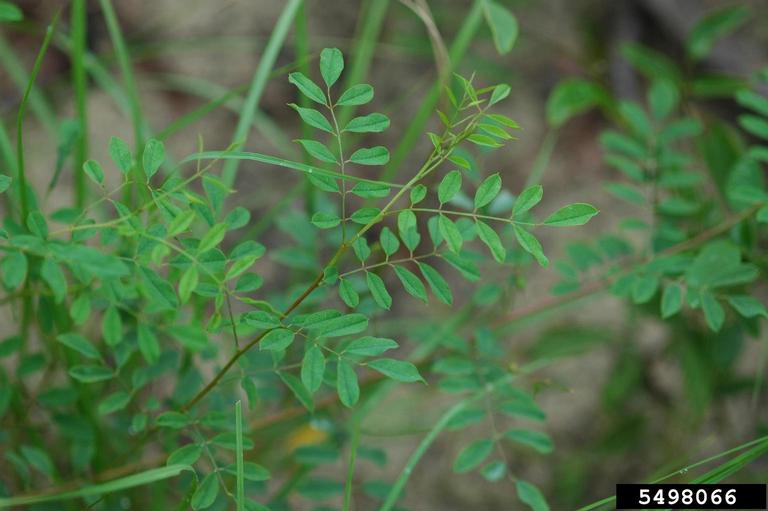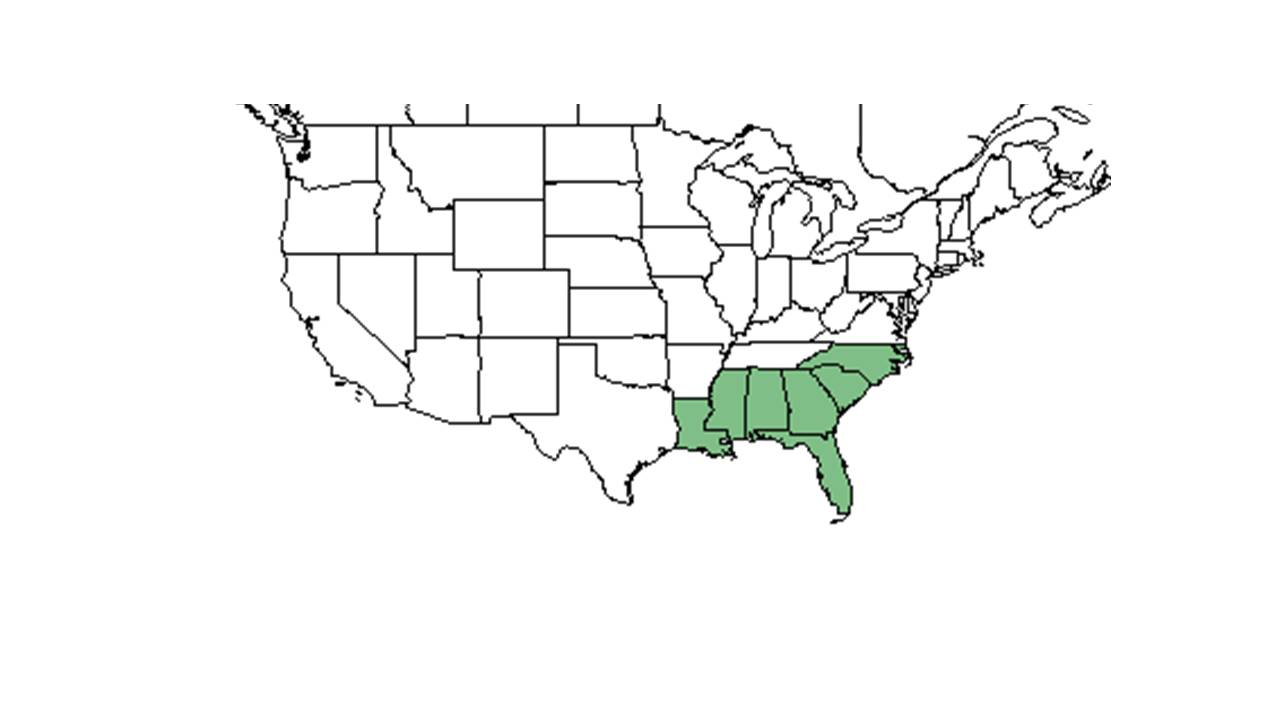Difference between revisions of "Indigofera caroliniana"
| Line 18: | Line 18: | ||
}} | }} | ||
| − | Common name: Carolina indigo; wild indigo<ref name= | + | Common name: Carolina indigo; wild indigo<ref name=weakley>Weakley, A.S. 2020. Flora of the Southeastern United States. Edition of 20 October 2020. University of North Carolina at Chapel Hill, Chapel Hill, North Carolina.</ref> |
==Taxonomic notes== | ==Taxonomic notes== | ||
| − | Synonyms: none<ref name=weakley | + | Synonyms: none<ref name=weakley/> |
Varieties: none<ref name=weakley/> | Varieties: none<ref name=weakley/> | ||
Revision as of 14:00, 2 June 2023
| Indigofera caroliniana | |
|---|---|

| |
| Photo by Karan A. Rawlins, University of Georgia, Bugwood.org | |
| Scientific classification | |
| Kingdom: | Plantae |
| Division: | Magnoliophyta - Flowering plants |
| Class: | Magnoliopsida – Dicotyledons |
| Order: | Fabales |
| Family: | Fabaceae ⁄ Leguminosae |
| Genus: | Indigofera |
| Species: | I. caroliniana |
| Binomial name | |
| Indigofera caroliniana Mill. | |

| |
| Natural range of Indigofera caroliniana from USDA NRCS Plants Database. | |
Common name: Carolina indigo; wild indigo[1]
Contents
Taxonomic notes
Synonyms: none[1]
Varieties: none[1]
Description
Where this species is found, it is frequent.[2]
"Suffruticose herb 0.5-1.2 (2) m tall. Leaves odd-pinnate, 5-10 cm long with a slightly strigillose rachis; leaflets 9-15, mostly obovate to oblanceolate, 1-2.5 cm long, 5-10 mm wide, minutely strigillose on both surfaces, trichomes appearing as though attached at their middle, stipellate. Racemes pedunculate, axillary or terminal, 6-20 cm long usually longer than subtending leaf, slender, with numerous, loosely arranged flowers; pedicel ca. 1 mm long, subtended by a triangular, subulate bract 0.8-1 mm long, lobes 0.20.4 mm long; petals pinkish to yellowish-brown, the standard and keel 5-6 mm long, the wings 1-2 mm shorter and adherent to the laterally pouched keel petals; stamens diadelphous, 9 and 1, with the connective extended above the anthers. Legume 5-10 mm long, short-stipitate, beaked, 1-3 seeded."[3]
The root system of Indigofera caroliniana includes stem tubers which store non-structural carbohydrates (NSC) important for both resprouting following fire and persisting during long periods of fire exclusion.[4] Diaz-Toribio and Putz (2021) recorded this species to have an NSC concentration of 152.6 mg/g (ranking 37 out of 100 species studied) and water content of 62.7% (ranking 73 out of 100 species studied).[4]
Distribution
Indigofera caroliniana is distributed from eastern North Carolina south to southern Florida, and west to southeastern Louisiana. It is considered a Southeastern Coastal Plain endemic species.[1]
Ecology
Habitat
Generally, this species can be found in sandhills, maritime forests, Florida scrub habitats, and other sandy woodlands or forests.[1] It is found along the edges of flatwoods, mixed woodlands, upland ridges, deciduous forests, slash pine-hardwood stands, sand pine scrub, and sand ridges. This species grows in sand and sandy loam in open areas. This species also occurs outside of its natural environments in human-disturbed areas such as open fields, bulldozed scrub oak sandhills, clobbered slash pine and hardwood fields, and wood pastures.[2]
Associated species include Longleaf pine, turkey oak, slash pine, sand live oak, myrtle oak, sand pine, chapman oak, Cuthbertia, Rhynchosia, and Pediomelium, shortleaf pine, red oak, mockernut hickory, wiregrass, and bluejack oak.[2]
Phenology
I. caroliniana generally flowers from June until August, and fruits from July until October.[1] It has been observed flowering in April, June through August, and in December with peak inflorescence in July.[2][5] It has been observed fruiting June through September.[2]
Fire ecology
This species occurs in areas that are burned.[2]
Pollination
Indigofera caroliniana has been observed at the Archbold Biological Station to host sweat bees such as Lasioglossum placidensis (family Halictidae) and leafcutting bees such as Anthidiellum perplexus (family Megachilidae).[6] Other members of the Hymenoptera order that have been observed pollinating I. caroliniana include Dialictus placidensis.[7]
Conservation, cultivation, and restoration
Since the overall range is restricted of this species, it is listed on the global scale as G4, but it is relatively common in the region. It is also listed as vulnerable by the state of North Carolina.[8]
Cultural use
Photo Gallery
References and notes
- ↑ 1.0 1.1 1.2 1.3 1.4 1.5 Weakley, A.S. 2020. Flora of the Southeastern United States. Edition of 20 October 2020. University of North Carolina at Chapel Hill, Chapel Hill, North Carolina.
- ↑ 2.0 2.1 2.2 2.3 2.4 2.5 Florida State University Robert K. Godfrey Herbarium database. URL: http://herbarium.bio.fsu.edu. Last accessed: June 2014. Collectors: Ed Keppner, Lisa Keppner, Loran C. Anderson, James R. Burkhalter, R.K. Godfrey, R. C. Phillips, C. Jackson, R L Lazor, Sidney McDaniel, Richard S. Mitchell, R. Kral, D. B. Ward, J. Beckner, O. Lakela, L. J. Brass, Roland McKee, Rodie White, Andre F. Clewell, R. Komarek, Richard R. Clinebell II, Cecil R Slaughter, B. E. Smith, R. L. Wilbur, William B. Fox, L. A. Whitford, James W. Hardin, Wilbur H Duncan, Ted Bradley, John Stevenson, H. R. Reed, John B. Nelson, A. Goodyear, R. Wetmore, Brian R. Keener, and Wayne K. Webb. States and Counties: Florida: Bay, Collier, Dixie, Duval, Escambia, Flagler, Franklin, Hernando, Highlands, Jackson, Leon, Levy, Liberty, Madison, Okaloosa, Taylor, Wakulla, and Walton. Georgia: Grady, McIntosh, Thomas, and Tift. South Carolina: Darlington. North Carolina: Bladen, Brunswick, Richland, and Sampson. Alabama: Henry, Mobile, and Wilcox.
- ↑ Radford, Albert E., Harry E. Ahles, and C. Ritchie Bell. Manual of the Vascular Flora of the Carolinas. 1964, 1968. The University of North Carolina Press. 624. Print.
- ↑ 4.0 4.1 Diaz-Toribio, M.H. and F. E. Putz 2021. Underground carbohydrate stores and storage organs in fire-maintained longleaf pine savannas in Florida, USA. American Journal of Botany 108: 432-442.
- ↑ Nelson, G. PanFlora: Plant data for the eastern United States with emphasis on the Southeastern Coastal Plains, Florida, and the Florida Panhandle. www.gilnelson.com/PanFlora/ Accessed: 12 DEC 2016
- ↑ Deyrup, M.A. and N.D. 2015. Database of observations of Hymenoptera visitations to flowers of plants on Archbold Biological Station, Florida, USA.
- ↑ Deyrup, M. J. E., and Beth Norden (2002). "The diversity and floral hosts of bees at the Archbold Biological Station, Florida (Hymenoptera: Apoidea)." Insecta mundi 16(1-3).
- ↑ [[1]] NatureServe Explorer. Accessed: May 31, 2019